Click on images to enlarge

infestation (Photo: Sheldon Navie)

habit being grown as a garden hedge (Photo: Sheldon Navie)
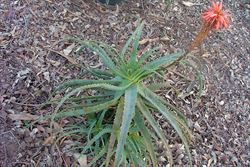
habit (Photo: Sheldon Navie)

habit of a large colony in flower (Photo: Sheldon Navie)
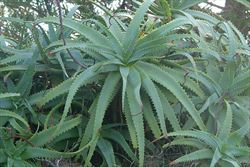
elongated fleshy leaves (Photo: Sheldon Navie)

close-up of leaf showing prickly margins (Photo: Sheldon Navie)
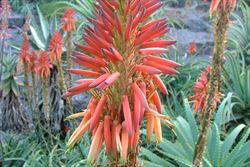
elongated flower cluster (Photo: Sheldon Navie)
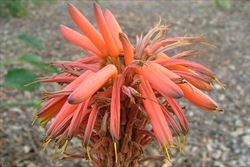
close-up of tubular flowers and flower buds (Photo: Sheldon Navie)

one of the long branches, covered with the remains of old leaves (Photo: Sheldon Navie)

elongated flower clusters borne on long stalks (Photo: Sheldon Navie)
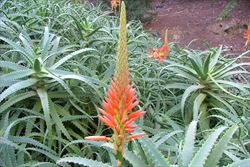
young flower cluster in bud (Photo: Sheldon Navie)

close-up of tubular flower with yellowish 'petal' tips (Photo: Sheldon Navie)
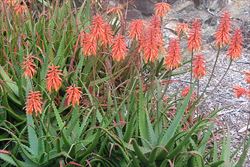
Cameron's aloe (Aloe cameronii), a similar species with green or reddish leaves and branched flower clusters (Photo: Sheldon Navie)

Aloe nyeriensis, a similar species with whitish spots near the bases of its leaves (Photo: Sheldon Navie)
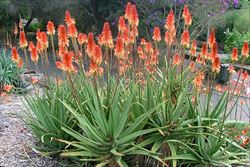
Aloe lutescens, a similar species with much shorter stems (Photo: Sheldon Navie)
Scientific Name
Aloe arborescens Mill.
Family
Aloeaceae (Victoria, Tasmania and the Northern Territory)Asphodelaceae (Queensland, New South Wales and Western Australia)Liliaceae (South Australia)
Common Names
aloe, candelabra aloe, candelabra plant, krantz aloe, mountain bush aloe, octopus aloe, octopus plant, shrub aloe, torch aloe, torchaloe, torchplant, tree aloe
Origin
Native to southern Africa (i.e. Malawi, Mozambique, Zimbabwe, South Africa and Swaziland).
Naturalised Distribution
Naturalised in the coastal districts of southern and central Queensland, in the coastal districts of northern New South Wales and on Lord Howe Island. Sparingly naturalised in south-eastern South Australia and near Melbourne in southern Victoria.
Possibly also naturalised in south-western Western Australia and in the coastal districts of central and southern New South Wales. The distribution of this species is probably underestimated by herbarium records, as it is difficult to collect and preserve.
Notes
Candelabra aloe (Aloe arborescens) is regarded as a minor environmental weed in Queensland and New South Wales. This succulent plant has escaped cultivation and mainly become naturalised in bushland in the warmer parts of eastern Australia. It is often planted as a hedge and is usually spread into natural areas in dumped garden waste.
It is most troublesome as a weed of sand dunes and other sandy coastal habitats, but is also found growing in urban bushland and riparian vegetation. Succulent plants, such as candelabra aloe (Aloe arborescens), can have a negative effect on coastal environments as they lead to an increase in soil nutrients and promote subsequent invasion by other weeds.
In Queensland, candelabra aloe (Aloe arborescens) has mainly been recorded as naturalised in the Moreton district. In New South Wales it has only been recorded as naturalised in the Kempsey district on the north coast, but there are numerous other reports of it being present in other coastal regions. For example, it is listed as a potentially troublesome weed in the coastal reserves on the south coast (e.g. in the Mystery Bay Foreshore area) and has been reported from similar areas on the central coast (e.g. in Burgess Beach Reserve in the Great Lakes Council area). It is also regarded as a potential environmental weed in Byron Shire and listed as an environmental weed in Blue Mountains City Council.

